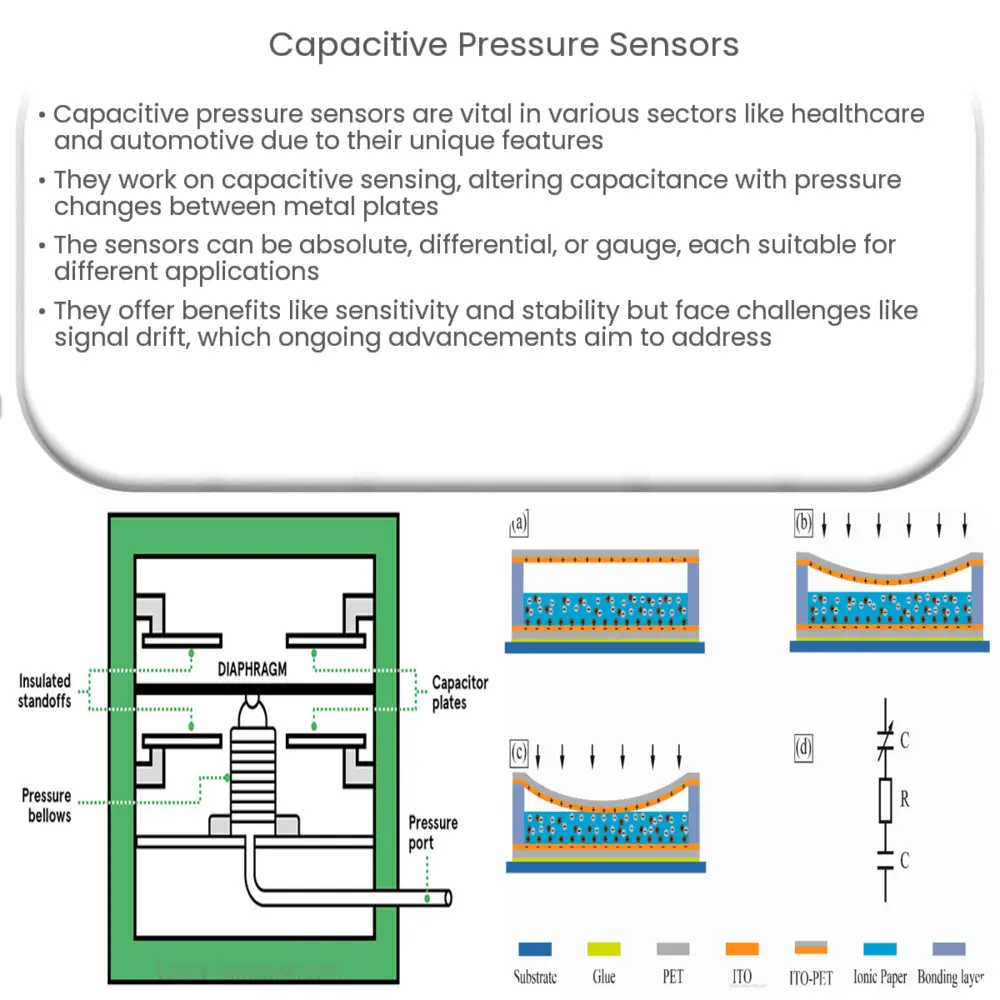Explore capacitive pressure sensors: their working principle, design, benefits, applications, challenges, and future prospects.

Introduction to Capacitive Pressure Sensors
Pressure sensors play a critical role in various sectors, ranging from healthcare to industrial control and automotive systems. Among the numerous kinds of pressure sensors available today, capacitive pressure sensors have emerged as an essential tool due to their unique features and benefits.
Principle of Capacitive Pressure Sensing
Capacitive pressure sensors operate based on the principle of capacitive sensing, which involves the change in capacitance due to mechanical deformation. These sensors comprise two metal plates with a dielectric material sandwiched in between. The capacitance is directly proportional to the surface area of the plates and inversely proportional to the distance between them. When pressure is applied to this system, it causes a change in the distance between the plates, which in turn modifies the capacitance. This change in capacitance can be measured and converted into a pressure reading.
Design and Construction
The design and construction of capacitive pressure sensors depend largely on their intended application. They can be designed as absolute, differential, or gauge sensors, each providing unique advantages for certain applications. The sensing element in these devices typically consists of a diaphragm which responds to pressure changes, and a reference element that serves as a baseline for the measurement.
- Absolute sensors have a sealed reference chamber with a known fixed pressure. These sensors measure the pressure relative to a perfect vacuum and are often used in weather forecasting and altitude measurements.
- Differential sensors measure the difference in pressure between two points. They are widely used in flow and level measurement in various industries.
- Gauge sensors measure pressure relative to atmospheric pressure and are commonly used in industrial processes and pneumatics.
Advantages of Capacitive Pressure Sensors
Capacitive pressure sensors are highly prized for their numerous benefits, including their sensitivity, low power consumption, and excellent long-term stability. They can be easily miniaturized without losing their performance characteristics, which makes them suitable for a range of applications.
The sensors are also highly resistant to environmental influences such as temperature fluctuations and vibrations, and they can withstand overpressure conditions, thanks to the inherent robustness of the capacitive sensing principle. This makes them a reliable choice for demanding applications where precise and consistent measurements are crucial.
Applications of Capacitive Pressure Sensors
Capacitive pressure sensors find application across various industries and fields. Here are some notable examples:
- Automotive industry: These sensors are employed for tire pressure monitoring, engine management systems, and cabin pressure sensing, among other applications.
- Healthcare: In the medical field, capacitive pressure sensors can be found in applications such as blood pressure monitoring, respiratory devices, and infusion pumps.
- Industrial process control: Capacitive pressure sensors help maintain process control in various industries, by monitoring pressure in pipelines and tanks, controlling hydraulic systems, and ensuring the safety of pressure vessels.
- Consumer electronics: Touch screen technology in smartphones and tablets leverage capacitive sensing principles. Though not a traditional ‘pressure’ application, it highlights the versatility of capacitive sensing.
Challenges and Future Directions
Despite the numerous advantages of capacitive pressure sensors, they do face some challenges. For instance, signal drift can occur over time due to changes in the dielectric constant of the materials. Additionally, they may be susceptible to interference from electromagnetic noise in some environments.
However, ongoing advancements in sensor design, material science, and signal processing are helping to overcome these hurdles. Micro-Electro-Mechanical Systems (MEMS) technology is paving the way for smaller, more integrated capacitive pressure sensors with improved performance characteristics. Sensor fusion, where data from multiple sensors are combined to improve accuracy and reliability, is another area of active research and development.
Conclusion
Capacitive pressure sensors, with their high sensitivity, low power requirements, and robustness, are undeniably essential tools in numerous fields today. Despite the challenges they face, their potential for further innovation and development is enormous, thanks to advancements in technology such as MEMS and sensor fusion. As these technologies continue to mature, it’s safe to predict that capacitive pressure sensors will continue to find new applications, improving efficiencies and enabling new capabilities in a range of sectors from healthcare to industrial process control, automotive systems, and beyond.

